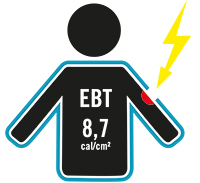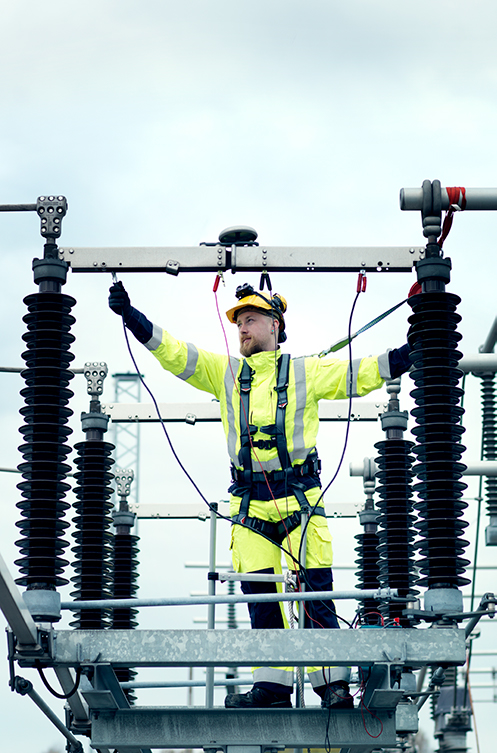
ELECTRIC ARC

EN 61482-2:2020 / IEC 61482-2:2018
Protective clothing against the thermal hazard of an Electric Arc
This standard specifies PPE Clothing when there is a risk of an Electric Arc – for instance when working with electricity on open equipment or maintenance / switching work. Electric Arc garments come under PPE Regulation Category III. Fabric properties and garment design are important parameters in the certification process of Electric Arc garments.

EN 61482-2:2020
ELIM: 8,1 cal/cm²
EBT: 8,7 cal/cm²
APC 1

IEC 61482-2:2018
ELIM: 8,1 cal/cm²
EBT: 8,7 cal/cm²
APC 1
During a transition period, Tranemo stock garments can have three different types of marking.
Working with electricity carries a risk of being injured by an Electric Arc. By wearing protective clothing that is tested and certified to withstand the energy of a possible Electric Arc, you help protect yourself against that risk. It is very important to wear protective clothing covering the whole body in order to achieve complete protection. To certify Electric Arc garments according to EN 61482-2, the protective clothing must be tested by at least one of the two different test methods: Open Arc EN IEC 61482-1-1 and Box test EN 61482-1-2.
OPEN ARC - EN IEC 61482-1-1
The test method Open Arc uses an open arc in a medium voltage range (> 1,000V), which is shot towards a fabric sample or a mannequin with protective clothing. Electrodes behind the fabric or garment register the heat transfer through the fabric/garment in order to determine when a person would receive a second degree burn.
In the first stage, the fabric is exposed to different energy levels to obtain an approved Arc Rating. The revised test method is now more strictly controlled and regulated than before, which can mean that previously obtained results may differ from new re-test figures. However, the protection of the clothing is still the same as before, despite the fact that the Arc Rating may sometimes be a lower value after re-testing. In stage two, the protective clothing is tested with the energy level determined by the fabric test result. A new requirement that has been added to the standard in that the tested garment must not have an afterburn time of more than 5 seconds.
In stage two, the protective clothing is being shot with the energy level from the result of the fabric test. All tests result in two different Arc Ratings based on shooting results and the Stoll curve - which is used to calculate the probability that a person will get a burn. The higher the value, the better the protection.
The first result, ELIM (Incident Energy Limit, cal/cm²), lets the user know how much energy the protective clothing can withstand without any risk (or 0% probability) of a second degree burn.
The second result is either ATPV (Arc Thermal Performance Value, cal/cm²) or EBT (Energy Break Open Threshold, cal/cm²), and lets the user how much energy the protective clothing withstands when there is a 50% probability of a second degree burn. ATPV indicates the energy level required when the temperature of the mannequins skin reaches a level where a second degree burn could occur. EBT indicates the energy level at which the fabric breaks open and can result in a second degree burn. ELIM indicates the Arc Rating for the entire garment and as additional information Tranemo also indicates the lowest result of ATPV or EBT.
 |  | The energy level where the heat from the Electric Arc is so high that it may cause a burn through the fabric. |  | The energy level where the fabric breaks open and may cause a burn. |
| ELIM - The maximum incident energy the garment can withstand before the wearer would have a 0% probability of a second degree burn. | ATPV - The maximum incident energy the garment can withstand before the wearer would have 50% probability of a second degree burn. | EBT - The incident energy at which a 50% probability of a breakopen occurs resulting in a second degree burn. |
Since ELIM indicates an energy value at 0% probability of a second degree burn and ATPV/EBT at 50% probability, the ELIM value is usually lower than ATPV/EBT. Large differences between the ELIM and ATPV/EBT results highlight the importance of wearing several layers of garments (such as in a Tranemo Skinsafe™ system) to ensure you are properly protected.
BOX TEST EN 61482-1-2
The Box test method uses a constrained and direct arc, created by a short circuit in an open cabinet at a low voltage range
(400V). The test is performed on fabric and protective clothing in the same way as for Open Arc. The result is stated as APC (Arc Protection Class):
APC 1 (formerly Class 1) – 168kJ (4kA, 400V), APC 2 (formerly Class 2) – 320kJ (7kA, 400V)
Unlike the American standard, there is not a result scale in this garment tests, only two levels where the garment either passes or
fails. A garment with one layer of Flame Retardant fabric usually passes APC 1 - even thin shirt fabrics.
To pass APC 2, a system with two or three fabric layers or a lined garment is normally required. This makes it more difficult
to adapt the protection to the risk, without compromising on comfort. As APC 1 is a relatively low level of protection, Tranemo
always recommends a basic protection of at least 8 cal/cm².
RISK ASSESSMENT ELECTRIC ARC HAZARD
Documents like NFPA 70E, ISSA Guidelines and DGUV-I 203-077 help to assess Electric Arc hazards from a practical perspective. The hazards of an Electric Arc include thermal effects from high heat, noise, pressure wave, shrapnel and flying debris, molten metal, optical damage, hearing damage and other effects. Therefor it is important that any risk assessment considers all of these potential hazards. To achieve correct levels of protection, it is important that the whole body is protected with supporting Arc PPE i.e. helmet with protective screen, ear protection, arc gloves and safety shoes together with the correct Tranemo protective clothing. There are two accepted Electric Arc risk assessment standards used in Europe; the American NFPA 70E and the German DGUV-I 203-077.
American standard for electrical safety in the workplace - NFPA 70E
This is the American standard for electrical safety in the workplace and is a consensus standard on how to protect workers from the hazards of an Electric Arc. The standard is formed to help employees and workers to understand electrical hazards, help with: risk assessment, arc rated PPE selection and electrical safe working practices. When choosing workwear and other PPE as protection against Electric Arc risks, NFPA 70E states two methods; Incident Energy Analysis or Arc Flash PPE Category method. Which one to use depends on whether the incident energy that a worker may be exposed to has been calculated or not.
Incident Energy Analysis in cal/cm² - NFPA 70E:2018 130.5 according to IEEE1584:2018
The strength of the protection must be greater than the force of the risk - meaning that the certified protection in cal/cm² must be greater than the Incident Energy Analysis in cal/cm². The table below shows what PPE should be worn and when:
The risk of Electric Arc is 1,2-12 cal/cm²
- Electric Arc approved jacket/trousers/boilersuit with long sleeves/ legs
- Electric Arc approved helmet/visor with balaclava or Electric Arc hood with integrated visor
- Electric Arc approved gloves, thick leather gloves or isolating gloves with leather cover
- Protective glasses under a visor
- Ear protection
- Comprehensive heavy-duty protective leather footwear
The risk of Electric Arc is >12 cal/cm²
- Electric Arc approved jacket/trousers/boilersuit with long sleeves/ legs
- Electric Arc hood with integrated visor shall cover the face (Electric Arc approved helmet/visor with balaclava is not approved)
- Electric Arc approved gloves (thick leather gloves or isolating gloves with leather cover is not approved)
- Protective glasses under a visor
- Ear protection
- Comprehensive heavy-duty protective leather footwear
Arc Flash PPE Category method - NFPA 70E:2018 130.7
The Arc Flash PPE Category method is only used when the Incident Energy Analysis has not been calculated. In the Arc Flash PPE Category method, you compare your workplace with those listed in NFPA 70E 130.7 where a recommendation of which PPE category to choose is stated. This method is more insecure and may cause the user to wear unnecessarily thick and heavy clothing, protecting to a level much greater than that which is required.
| The Electric Arc protection for clothing is divided into four PPE categories: | ||||
| Risk Assessment acc. to Arc Flash PPE Category method (cal/cm²) | 1,2-4 | 4-8 | 8-25 | 25-40 |
| Requirement of the PPE Arc Rating (cal/cm²) | > 4 | > 8 | > 25 | > 40 |
| Requirement of PPE category | PPE 1 / CAT 1 (4-8 cal/cm²) | PPE 2 / CAT 2 (8-25 cal /cm²) | PPE 3 / CAT 3 (25-40 cal /cm²) | PPE 4 / CAT 4 (>40 cal/cm²) |
The table below shows what PPE that shall be worn:
When the Electric Arc hazard requires use of PPE 1 or 2
- Electric Arc approved jacket/trousers/boilersuit with long sleeves/ legs
- Electric Arc approved helmet/visor with balaclava or Electric Arc hood with integrated visor
- Electric Arc approved gloves, thick leather gloves or isolating gloves with leather cover
- Protective glasses under a visor
- Ear protection
- Comprehensive heavy-duty protective leather footwear
When the Electric Arc hazard requires use of PPE 3 or 4
- Electric Arc approved jacket/trousers/boilersuit with long sleeves/ legs
- Electric Arc hood with integrated visor shall cover the face (Electric Arc approved helmet/visor with balaclava is not approved)
- Electric Arc approved gloves (thick leather gloves or isolating gloves with leather cover is not approved)
- Protective glasses under a visor
- Ear protection
- Comprehensive heavy-duty protective leather footwear
Letter of conformance - NFPA 70E / EN 61482-2
Tranemo has (in collaboration with ArcWear, an accredited testing institute in the USA) produced a conformance letter showing that our PPE, when certified according to EN 61482-2, meets the requirements of the American standard NFPA 70E. The letter confirms that Tranemo’s CE-marked Electric Arc garments can also be used in the US market.
German standard for risk assessment according to DGUV-I 203-077 and risk calculations according to BGI/GUV-I 5188
The German standard is based on risk assessment according to DGUV-I 203-077 and risk calculations according to BGI/GUV-I 5188. According to the standard, the protective clothing is tested according to EN 61482-1-2 Box test with a limited and direct arc created by a short circuit in a open cabinet. The test is performed in a low voltage range (400V).
TRANEMO SKINSAFE™
Wearing several layers of Electric Arc protective clothing significantly increases protection, due to the formation of air gaps between the garment layers due to the fact that air has low electricity conductivity. It is important to understand that the total protective value of a multi-layer system cannot be calculated by simply adding energy values from the individual garments.
To determine the energy value of a multi-layer system, an Electric Arc test (corresponding to the way the garments would be worn in reality) must be carried out on a mannequin with the relevant garments layers. We call our tested multi-layer systems Tranemo Skinsafe™, which provides a greater opportunity to choose the right protective clothing based on your risk assessment.
As noted in NFPA 70E, and from experience in Tranemo Skinsafe™ tests, multiple layers of Electric Arc protective clothing are an effective way to achieve the protection required with the lowest combined weight. The use of a layering system therefore provides higher levels of comfort for the wearer and ensures that the correct protective clothing is always used.
ASTM F1959
The American performance standard for Electric Arc fabrics is called ASTM F1506 where fabric specifications also include the Open Arc test ASTM F1959. This standard is similar to the European test method EN IEC 61482-1-1 for fabric and garments. The biggest difference of the American standard compared to the European standard is the Char Length test - where a maximum char length is determined. The test is done after 25 washes and to pass, the char length it is allowed to be a maximum of 152 mm after 12 s exposure. Tranemo has tested our fabrics that are developed principally for working with electricity - Tera TX and Aramid 6.4FC. The test provides a useful indication of the fabrics flame retardant properties in an Electric Arc accident.
Electrical insulating protective clothing against Electric shock or clothing for work intentionally using an Electric Arc (such as arc welding and plasma torch cutting) IS NOT covered by the European EN 61482-2 standard.


